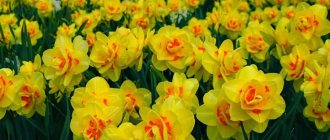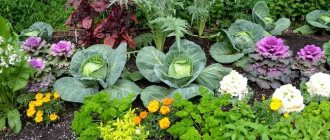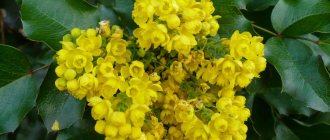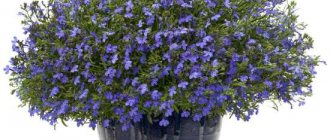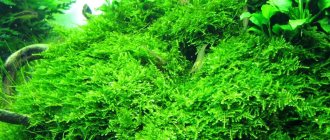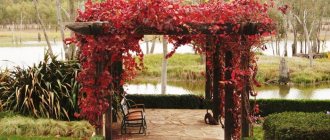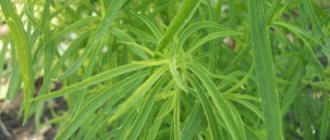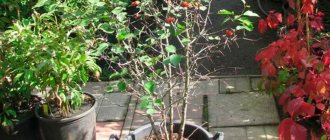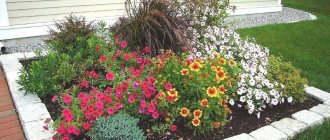Hosta began to be used in landscape design due to its elegant decorative effect. This plant has amazing plasticity, so it will become a true decoration of any garden. The variety of species and varieties that is characteristic of hosta amazes even the most experienced designers. This plant's leaves have different colors and shapes, so hosta is often used in garden landscape design.
What is a plant
Hosta, currently used in landscape design, is a frost-resistant plant that is easy to care for.
Advice! Thanks to its high decorative characteristics, hosta is ideal for landscape design of a personal garden.

This plant multiplies, bringing unique beauty to the garden, even when used individually. Professional landscape specialists advise planting it near bodies of water, on rocky slopes, and also in separate flower beds.
The hosta also looks good near the front entrance of the house.
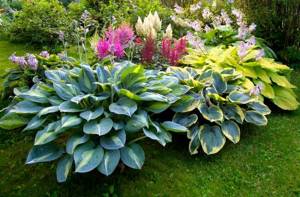
Among the characteristic properties inherent in this plant, one can note the absence of a stem and thickened rhizomes. The root has a cord-like appearance, so it is perfectly fixed in the soil.
Professionals prefer to use hosta in landscape design, since it is not capricious, and other plants can be planted next to it.
Attention! Hosta does not tolerate direct sunlight!
If you plant this plant on the sunny side of the site, most likely the flowerbed will have a very unpresentable appearance.
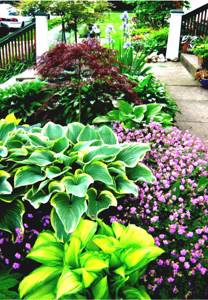
Hosta is actively used in landscape design due to its diversity in size, shape, and leaf color. First of all, professional stylists value the leaves of this plant. Despite the fact that in its appearance, hosta resembles a plantain, in fact its origin is connected with Japan.
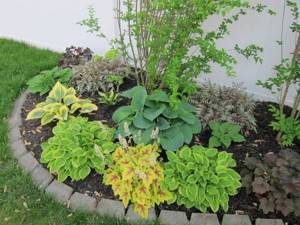
In Europe, this original plant appeared only in the eighteenth century. Thanks to the selection work of designers, hosta is now considered a real decoration in many landscape areas. Professionals often call hosta the queen of the landscape and try to use this plant in their work.
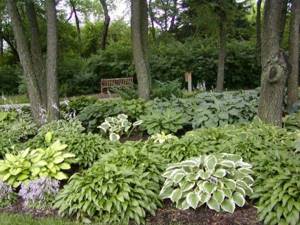
Creating a contrast of compositions and shapes
To create a bright, contrasting flower garden, the elements of which, harmoniously complementing each other, form a complete picturesque picture, a number of points should be taken into account.
Lush hosta bushes with monochromatic leaves play more of a background role in landscape design. They go well with garden plants: astilbes, peonies, dicentras, ferns.
In appearance, dicentra flowers resemble small hearts. Caring for this plant comes down to a few rules:
The decorative role of single planting is given more to large varieties and specimens with two or three-color leaves. Such variegated bushes look like large flowerpots filled with huge bouquets placed in the corners of the garden.
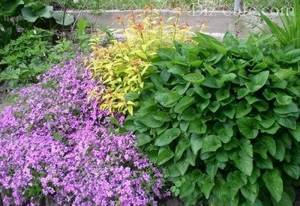
Plants with small foliage will be successful partners for hostas: purple periwinkle, awl-shaped phlox, blue forget-me-nots, poppy and rhododendron
Decorative varieties of coniferous plants help to effectively emphasize the spreading nature and beauty of the hosta.
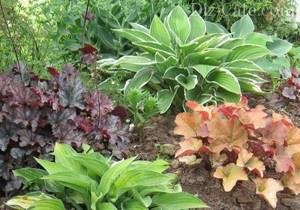
Bright contrasts in the composition can be obtained by planting herbaceous plants with a different shade of leaves near the hosta, for example: heuchera with purple foliage or bitter weed with burgundy leaves
Material on planting and caring for heucheras may also be useful:
The vertical accent of the plant composition is given by: phlox, kupena and daylilies. Grains help complete the composition: miscanthus and reed grass.
Types and varieties
Currently, there are about four thousand hybrid varieties of hosta. They are divided into groups according to characteristics and characteristic parameters. Among those types that are mostly used in landscape design, we note:
- Curly, the height of which reaches sixty centimeters. This plant is distinguished by wide, dark green leaves with white edges;
- Fortune does not exceed fifty centimeters, its dark leaves have a wavy edge;
- swollen hosta (up to half a meter) has pointed ends at the leaves;
- Siebold has a vein on the leaves, and the plant itself reaches 60 centimeters
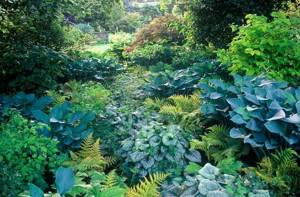
Landscape specialists divide hostas by color: yellow, green, blue. There are also two groups distinguished by unusual leaves with a border:
- variegata has a white border on a green leaf;
- Mediovariegata has a light leaf with a green edge.
Depending on the height, the hosta is divided into small, large, dwarf, giant, and miniature.
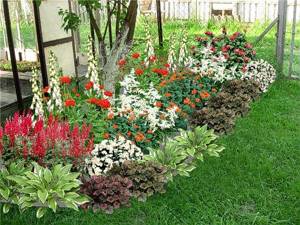
Successful compositions
To create a beautiful composition, you need to decide what the hosta goes with. This primarily applies to short species.
You can and should fantasize
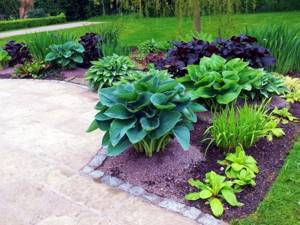
The combination of several types of functions in one flower bed looks great. In this case, you can play with variations in the color and shape of the leaf plates. Of course, the light requirements of all plants should be similar.
Tall varieties can easily grow on their own, forming luxurious clumps. Such decorations for a shady corner of the dacha look good on the lawn, framed by gravel or shade-tolerant dwarf relatives.
Flower growers have long been combining funkia with other plants in landscape design. Heucheras and hostas complement each other perfectly, but only if they have enough space to grow. Using these plants, you can make a beautiful frame for a path or decorate, for example, a seating area with an elegant ribbon.
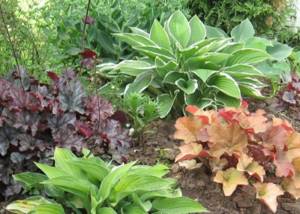
When planting hosta together with heuchera, you need to think about the color scheme in advance and select the necessary varieties. Heuchera can bring its own bright strokes to the palette - from greens to yellows and purples.
To make the flower bed look as elegant in the spring as in the summer, you can plant early-flowering bulbs next to the hosta, which do without autumn digging:
- snow-white pushkinia and snowdrop;
- sky-blue scillas and “melange” - with a transition from white to blue - muscari.
Harmony and style
This is perhaps the first definition that comes to mind when looking at the organic combination of lush multi-colored panicles and elegant restraint of foliage. Flowerbeds of low-growing hosta and astilbe species have long won the hearts of gardeners for many reasons:
- perennials thrive in shaded areas, turning dull, dull landscapes into beautiful alleys;
- plants live well even in conifers;
- They bloom for a long time in the second half of summer where, due to the lush crowns of trees, there is very little sunlight.
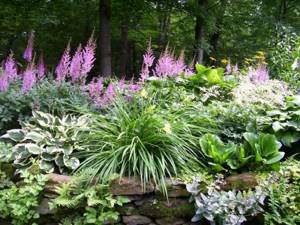
By forming flower beds from astilbes and hostas of different varieties, you can create fantasy compositions, planting them in even rows or arcs, zigzags, alternating with each other, combining colors - unlimited scope for the creativity of the landscape designer. The main thing is not to overdo it, otherwise there is a risk of turning an elegant group into a chaotic mixture of everything that you managed to purchase in a flower shop.
Loading…
Features of using hosta in landscape design
The leaves of this plant are of interest and value, from the point of view of landscape art. Hostas are used in various styles, from classic options to Japanese gardens.
Advice! This green beauty is an excellent option for the center of a flower bed in a garden plot.
Hosta in landscape design is most often chosen by professionals. They are convinced that this plant is appropriate in any interior design. Some craftsmen believe that the buds spoil the created image, so they eliminate the arrows of the flower stalks that appear on the plant. For other masters, the presence of buds is not an obstacle to the realization of their creative ideas.
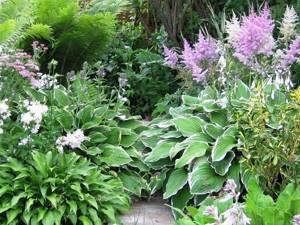
With the help of hostas with flowers, you can give the site a romantic atmosphere of French Provence. A three-year-old hosta can occupy an area of about one meter in width. Despite the unpretentiousness of this plant, it is advisable to plant the hosta in areas with partial shade. For example, such a plant will be an excellent limiting element for ponds and garden paths.
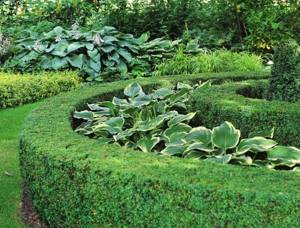
Attention! Hosta is suitable for sunny areas of the garden; the leaves are yellow in color.
Hosta is rightfully considered a unique plant, since it can be used in landscape design for different purposes:
- as a ground cover for places with partial shade;
- in the form of a frame near ponds, on garden paths
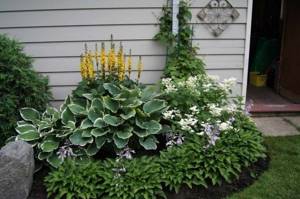
It is the hosta that is used as an important element in European landscape design. This plant is perfect for container decoration; it can be used to decorate individual parts of the garden.
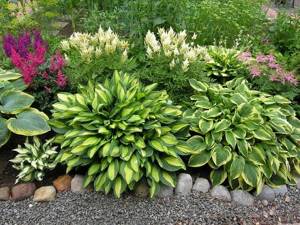
Advice! A win-win option would be a combination of hosta and astilbe in landscape design.
Astilbe has bright and beautiful flowers that will look harmonious against the greenery of the hosta.
Designers get an interesting combination by choosing low hostas and heucheras for work. These plants will be an excellent option for decorating an alpine slide. For example, hosta softens the massiveness of bergenia, making the landscape more comfortable and harmonious.

Among other options for using hosta in landscape design, we note the use of this plant in the form of a “pillow” at the base, which serves as a vertical support.
Hosta also often serves as one of the elements in a multi-layer border. Dwarf species of this plant are excellent for decorating alpine slides, rocky displays, and creating rose gardens in your backyard.
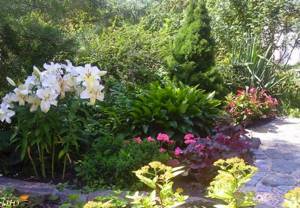
A flowerbed created only from a variety of hosta species will have an original look. Professionals do not set clear boundaries on the number of a given plant, their size, shape and color of leaves.
Advice! The more plants of different species are taken for landscape design, the better results can be achieved.
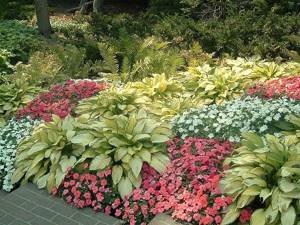
You can create a real mosaic from several species of this plant, capturing the imagination of your guests. The main charm of the created garden will lie in its asymmetry. Professional landscape designers recommend planting young plants at a small distance from each other, but so that they do not interfere with the development of neighboring bushes. Along the perimeter of such a garden plot, you can place a pile of wood chips, pebbles, lay paving slabs or cut down trees.
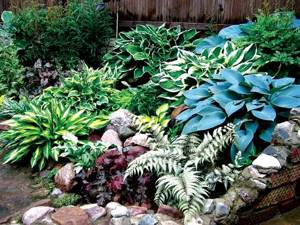
What to plant next to hostas
Hosta diseases
What does hosta go with in a flowerbed? These ornamental plants get along well with all flowers, so the question of what to plant next to the hosta does not arise. Previously, this perennial plant could rarely be found in flower beds and flower beds. It was considered something special among the usual plants and flowers. Modern varieties decorate flower beds and paths. They look wonderful surrounded by roses, peonies, hydrangeas, and irises. A good tandem of hostas in a flower bed with geraniums. These plants are a decoration for any flower garden: from a ceremonial composition to a shady corner in a landscape style.

Hosts in company with peonies
Use these attractive plants in your flower beds to enhance the attractiveness of the flowers around them. Large, ornamented hosta leaves soften, soothe, balance plants of various natures, and enhance the beauty of their neighbors, namely:
- Flower beds with daylilies and hosta. Low-growing types of daylilies are grown in the garden plot. They mainly decorate flower beds that look like alpine slides. At the forefront of the composition, florists recommend planting hostas with beautiful foliage. Depending on the design for the alpine hill, they select a scheme for planting bushes, alternating them with daylilies, which are suitable for any soil and diffused lighting.
- Flowerbed with phlox, heuchera and hosta. A skillful combination of heuchera and hosta with an eye-catching variation in the shades of one and the other flower transforms the area, be it a flower bed, lawn or alpine hill, and attracts attention. Both flowers are easy to care for and resistant to disease, frost and dry weather. Corners of garden plots decorated with heuchera and hosta are a real highlight of the design. In a semi-shaded area of the garden, perennial phlox will look like a bright spot, blooming almost all summer until mid-autumn. Dry summers, like winter frosts, are not so sensitive for phlox.
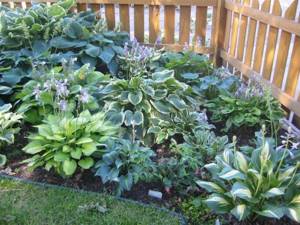
Combination of heuchera and hosta
Original solutions for garden landscape design
For those owners of summer cottages who do not have enough time to water and care for the plants planted on the site, professional stylists advise choosing “portable gardens”. For example, by placing hostas in huge flower pots, you can change their location at any time by moving from one area of the garden to another.

Attention! Only low-growing species are suitable for planting in pots.
Find many interesting solutions regarding the use of hosta in modern landscape design here
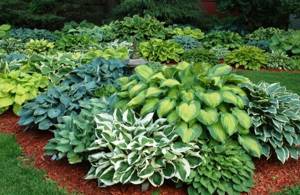
The best landscape solutions
Since there are many types and varieties of hosta in nature, it is important to understand which plant is suitable for a particular design solution.
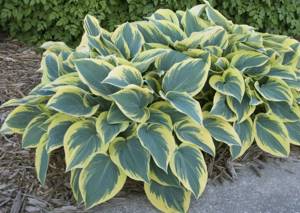
In order to determine the best use for this plant, you need to follow some rules:
- Large species reaching a height of more than half a meter are suitable for individual plantings. Such hosts look great on their own, quite self-sufficient, so the proximity of other crops would be unnecessary.
- If you plan to decorate the border with hostas, then you should give preference to plants that are medium in size. This way they will be visible in the foreground, and their taller neighbors will remain perfectly visible behind them.
- Small-sized varieties should be planted near rockeries (mini-gardens made of stones). They can be placed not in the foreground, but as a background for blooming greenery.
- If you are lucky enough to arrange a pond on your site, then the hosta will feel great in the company of moisture-loving crops on the very shore.
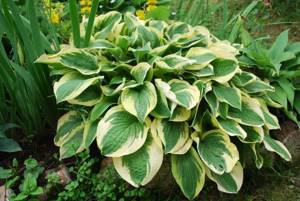
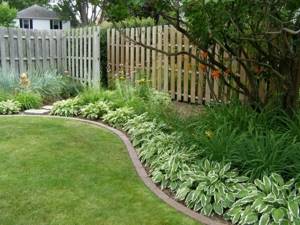
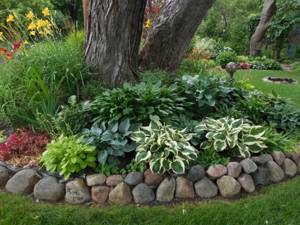
Hosta is a long-lived garden resident that becomes more lush and beautiful with age. Can live more than 25 years.
Reproduction methods
Hosta can be propagated for use in site design in various ways. The simplest and most convenient option is to use cuttings.
In addition to cuttings, you can also propagate this plant using seeds.
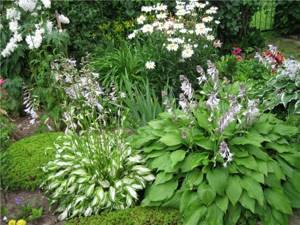
They can be collected after the fruit has ripened and a sweaty capsule has formed on the plant. The success of growing green beauty is influenced by the correct preparation of the seed.
First, you need to soak the seeds in special growth stimulants: “Kornevin”, “Epin”, or use aloe juice for similar purposes.
Attention! Professionals remind you of the obligation to treat seeds with special stimulants.
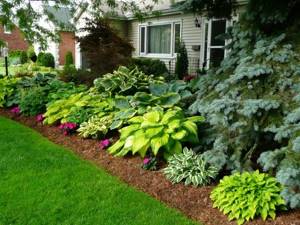
Among the important aspects that need to be paid close attention to is the sterility of the soil. It should not contain microorganisms that will interfere with the development of the plant.
In the absence of high-quality disinfection, there is a high risk of growing diseased plants, which will not only die themselves, but also destroy other flowers.
Professionals call purchasing a ready-made substrate in a store as the optimal solution. The composition should contain the following components: perlite, vermiculite, peat.
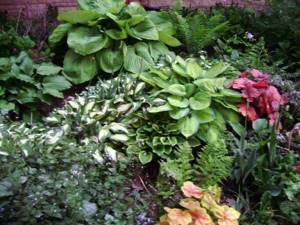
Advice! In order to avoid the development of fungi and other microorganisms, you must first thoroughly disinfect the pots with medical alcohol.
Only after this the finished mixture is poured into them, moistened, the seeds are laid out on the surface, and they are sprinkled with a layer of substrate, the thickness of which is approximately 0.5 centimeters.
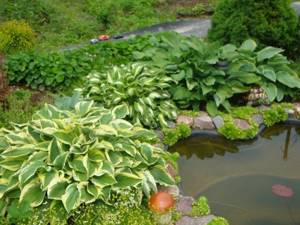
It is advisable to cover flower pots with transparent plastic film or glass from the moment of planting until the appearance of the first shoots. In this case, you can provide a constant temperature to the plant ranging from +18 to +25 degrees.
As soon as the seedlings appear, professionals advise watering them regularly, and be sure to keep them away from direct sunlight.

An accelerated method of propagation on a hosta plot is cuttings. This method is suitable for spring or autumn. The bushes of the plant are divided into sprouts, the cuttings are cleared of leaves, and planted in semi-dark areas of the garden. At first they will wither and look lifeless. This phenomenon is considered the norm, so the seedlings will come to life fairly quickly. The hosta reaches its maximum size two years after planting, which is when it can be planted in a permanent place in the garden.
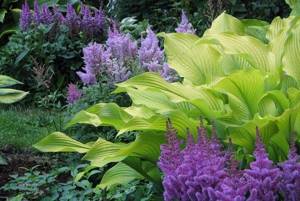
Proper care of a flower garden with hosta
The main guidelines when planting hosta and its combination with other annual and perennial plants, from a technical point of view, are soil moisture, soil type, location and location of groundwater. That is, the same parameters that you take into account when choosing a location for any representative of the flora on your personal plot. The plants you combine with hosta do not necessarily have the same flowering period. It will be better if the flowers replace each other. But it is very important that the flowerbed partners agree on issues that relate to the habitat. Otherwise, by watering the hosta, you will harm your partner who does not like moisture. And vice versa.
If we think from the point of view of the hosta, then this plant prefers:
- country locations that are well shaded in the afternoon;
- soil with a neutral reaction or slightly acidic soil;
- moderately moist soil in which moisture does not stagnate, but which does not have time to dry out from watering to watering.
With the arrival of cold weather, hostas do not need to be covered. In Ukrainian realities, they spend the winter quietly without any shelter. These ornamental plants are frost-resistant, so they cope well with temperature changes and are not afraid of winter weather. The hosta is ready to grow in the same place for ten years in a row. Especially if you feed it with organic matter once a year. For example, in the middle of the spring season or at the beginning of the autumn.
Hostas, whose leaves are colored blue and gray, love shade most of all. And varieties with bright green and yellow foliage, as well as multi-colored hostas, prefer partial shade, which allows them to reveal all their decorative potential.
Hostas are not only surprisingly unpretentious plants. You have probably already seen that they are universal in terms of combination with other flowers and decorative flora that can be found in a country garden. The main thing is to choose the right hosta variety so that the color and structure of the foliage, as well as the height of the bush, harmoniously combine with the appearance of other annuals and perennials, creating lush and beautiful compositions. And it’s never a sin to play with contrast: if the hosta you choose has heart-shaped leaves, plant a plant with an elongated leaf blade next to it. And if the hosta has boat leaves, choose a carved partner or neighbor with rounded foliage.
